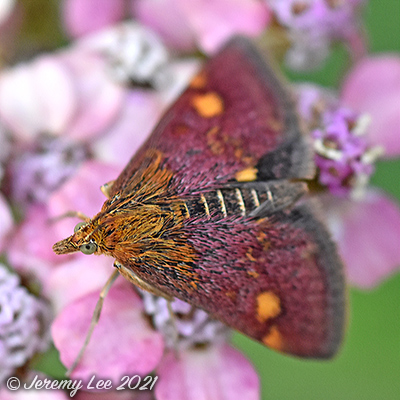
 |
|
Scientific Classifications explained » Amphibians » Ants » Aphids » Bees » Beetles » Birds » Bugs » Butterflies » Caterpillars » Damselflies » Dragonflies » Earwigs » Flies » Frog/Leafhoppers » Fungi » Galls » Grasshoppers » Harvestmen » Hoverflies » Lacewings » Ladybirds » Leaf Mines » Lichens » Mammals » Millipedes » Mosses » Moths » Sawflies » Slugs » Snails » Spiders » Trees » Wasps » Wild Flowers » Woodlice |
UK Nature > Moths > Pyrausta aurata

Scientific Name: Pyrausta aurata Common Name: Mint Moth Pyrausta aurata, more commonly known as the Mint Moth, has a wingspan of around 16-18 mm and is is superficially similar to the closely-related Pyrausta purpuralis, but this species has generally fewer gold markings on the wings, with a single distinct gold spot on the forewing. It was a rarity up to about a hundred years ago; nowadays becoming quite common, at least locally, because of mint, its larvae's food source of choice, being planted more often in suburban gardens; hence its common name. Locally common in England, Wales and southern Scotland. The adults fly from mid May until the end of June and from mid July until mid September, both in sunshine and after dark, and readily come to light. The larvae feed on various wild herbs, including mint (Mentha sp.) and marjoram (Origanum vulgare). When young, they live on the under surface of a leaf , but later they change to the flowers where they spin a web. |
|

https://www.uknature.co.uk is a website dedicated to showing the immense diversity of UK nature and wildlife. Our vast range of habitats, from lowland arable to snow covered mountains, from storm-ravaged coastlines to peaceful inland freshwater lakes and rivers, from dry, sandy heaths to deciduous and coniferous forests, all these habitats contribute to the abundance of UK nature. We have wild birds in huge numbers either residing or visiting our shores (597 recorded species as at July 2013) and we must also not forget the humble back garden with its grass lawns, flower beds filled with nectar rich flowers, shrubs and trees, all designed to attract huge numbers of insects such as bees, moths, butterflies and hoverflies; and finally the small ponds which provide safe havens for frogs, toads, newts and even slow worms and grass snakes. www.uknature.co.uk is the showcase for my personal passion, photographing uknature in all its glory. I sincerely hope you all enjoy the fruits of my labours. This site and all images contained therein is © Jeremy Lee 2004 - 2021. All Rights Reserved. Site design by Jeremy Lee. Site development & IT Support by Stuart Lee. |